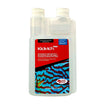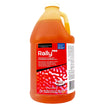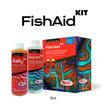- No products in the cart.
Effective Marine Ich Treatment Solutions That Are Safe for Reef Aquariums
29
Jul
Marine ich, also known as white spot disease, is a common parasitic infection affecting saltwater fish in aquariums. It's caused by the ciliate protozoan Cryptocaryon irritans. Treating marine ich effectively while ensuring the safety of reef inhabitants poses a significant challenge due to the sensitivity of coral and other invertebrates to common medications. However, with careful management and the right approach, it is possible to eradicate this pest while keeping your reef safe. Here are the most effective reef-safe treatment options for marine ich.
Understanding Marine Ich and Its Impact on Reef Aquariums
Marine ich manifests as small, white cysts on the skin, gills, and fins of fish. Infected fish may scratch against objects due to irritation, show increased respiratory effort, and eventually become lethargic and stop eating. The lifecycle of Cryptocaryon irritans makes it a formidable opponent, as the parasite goes through several stages, some of which are immune to treatment.
- Quarantine: The First Line of Defense - The best practice for handling marine ich starts with prevention. Quarantining new fish for at least two to four weeks can help prevent the introduction of the parasite into your reef tank. If marine ich is detected during quarantine, treatment can be applied in this controlled environment without risking the health of your main tank's inhabitants.
- Tank Environment Management - Adjusting environmental parameters can sometimes help manage minor outbreaks. Increasing the temperature of your aquarium to 80-82 degrees Fahrenheit can speed up the lifecycle of the parasite, allowing other treatments to be more effective. However, it’s crucial to ensure all species in the tank can tolerate this temperature change.
- UV Sterilizers - UV sterilizers can be a powerful tool in controlling parasites like marine ich. These devices use ultraviolet light to kill free-swimming stages of the parasite as water passes through the sterilizer. While UV sterilization won't cure infected fish directly, it can prevent the spread of the disease and reduce the overall parasitic load in the aquarium.
- Ozone Generators - Similar to UV sterilizers, ozone generators improve water quality and reduce the spread of infectious agents by breaking down organic waste and pathogens through oxidation. Use of ozone must be carefully controlled, as it can lead to oxygen depletion if mismanaged, which is harmful to both fish and coral.
- Reef-Safe Medications - While many traditional ich treatments can harm invertebrates and corals, there are several reef-safe options available:
Copper-free Medications: Products like Polyp Lab Medic or Ruby Reef Rally are formulated to be safe for most invertebrates and can treat ich in a reef environment.
Herbal Treatments: Herbal and botanical extracts, such as those found in products like Two Little Fishies ReVive Coral Cleaner, can help soothe infected fish and bolster their immune response without affecting the water chemistry in a way harmful to corals.
- Biological Controls - Introducing certain fish that naturally groom other fish, such as cleaner wrasses or neon gobies, can help manage ich by removing parasites from infected individuals. However, these species should be chosen carefully, with attention to their compatibility with other tank inhabitants and long-term care needs.
Conclusion
Managing marine ich in a reef aquarium requires a multifaceted approach that prioritizes the health of both the fish and the invertebrates. By combining environmental management, mechanical methods like UV sterilization, and selective use of reef-safe treatments, you can maintain a healthy, vibrant aquarium free of marine ich. Remember, prevention is always better than cure; thus, a robust quarantine protocol cannot be overstated in its importance for keeping your reef safe and thriving.





